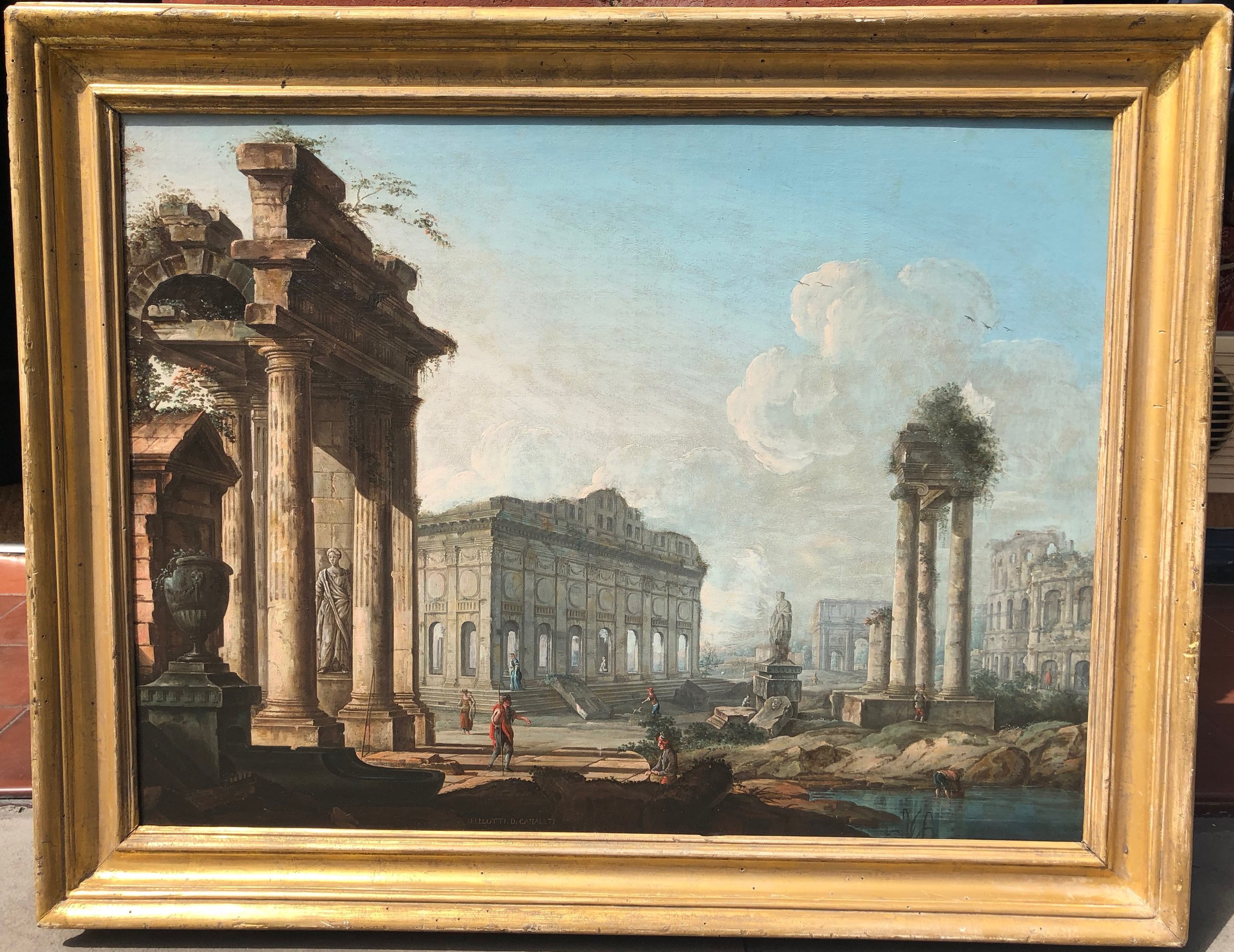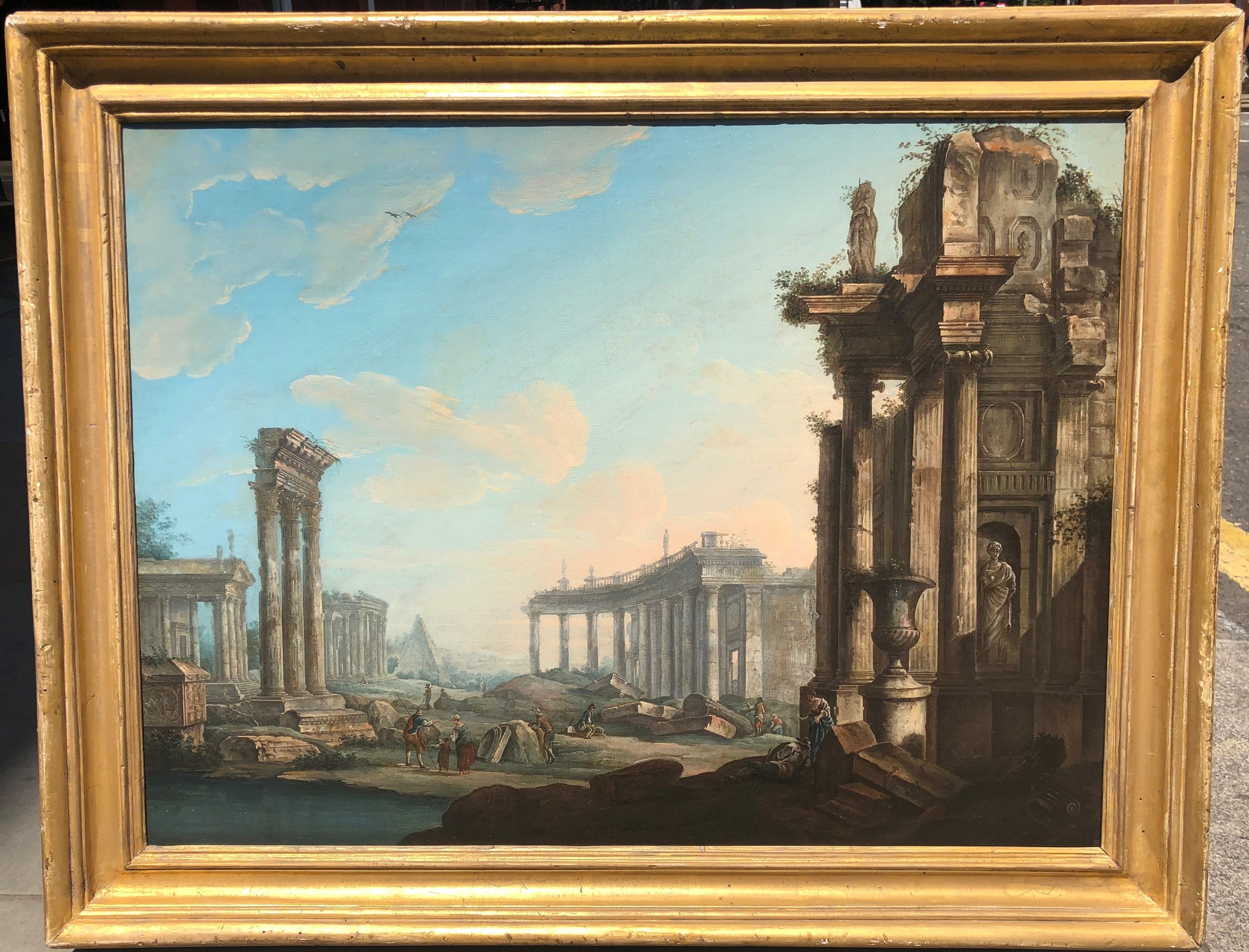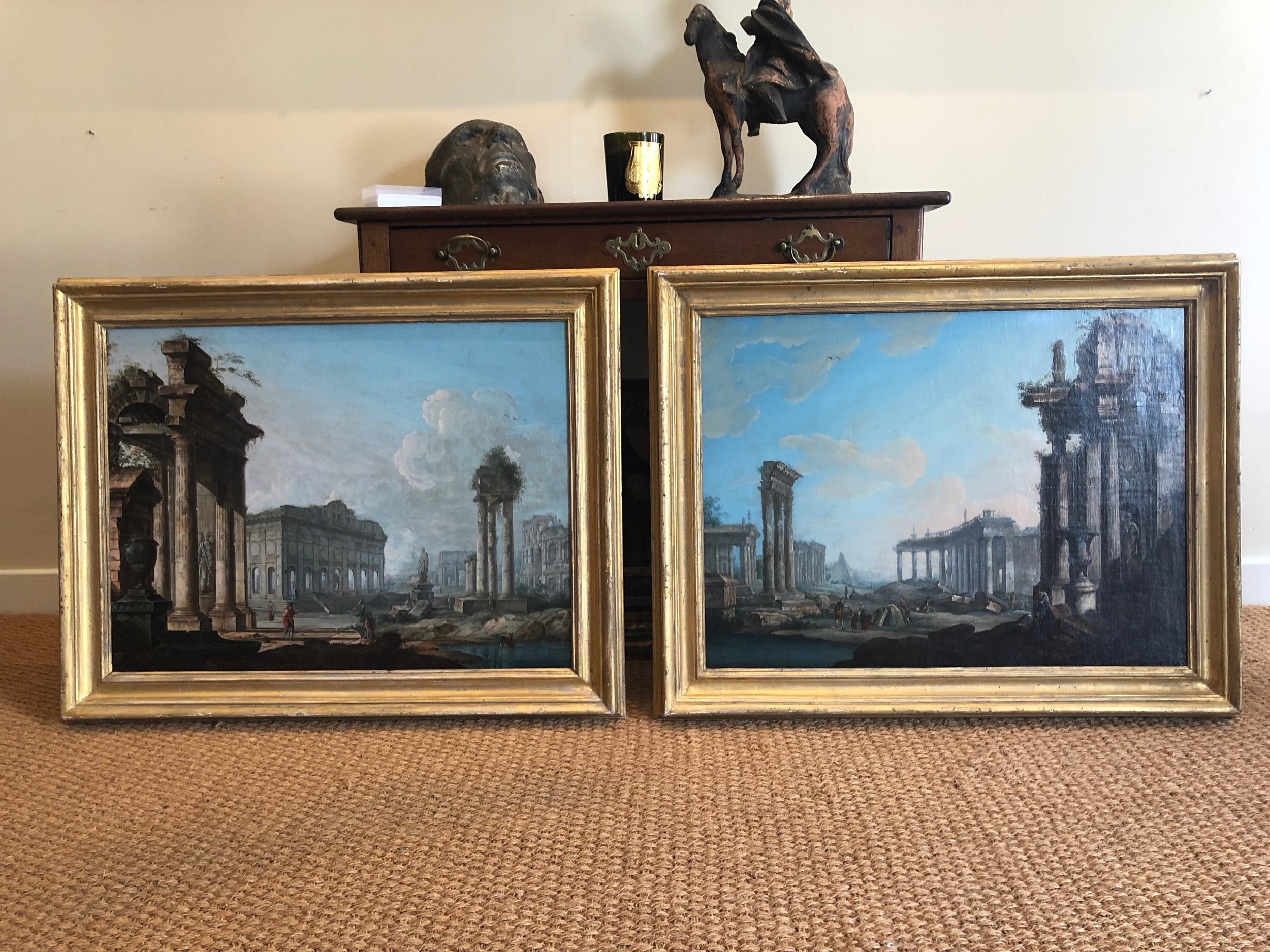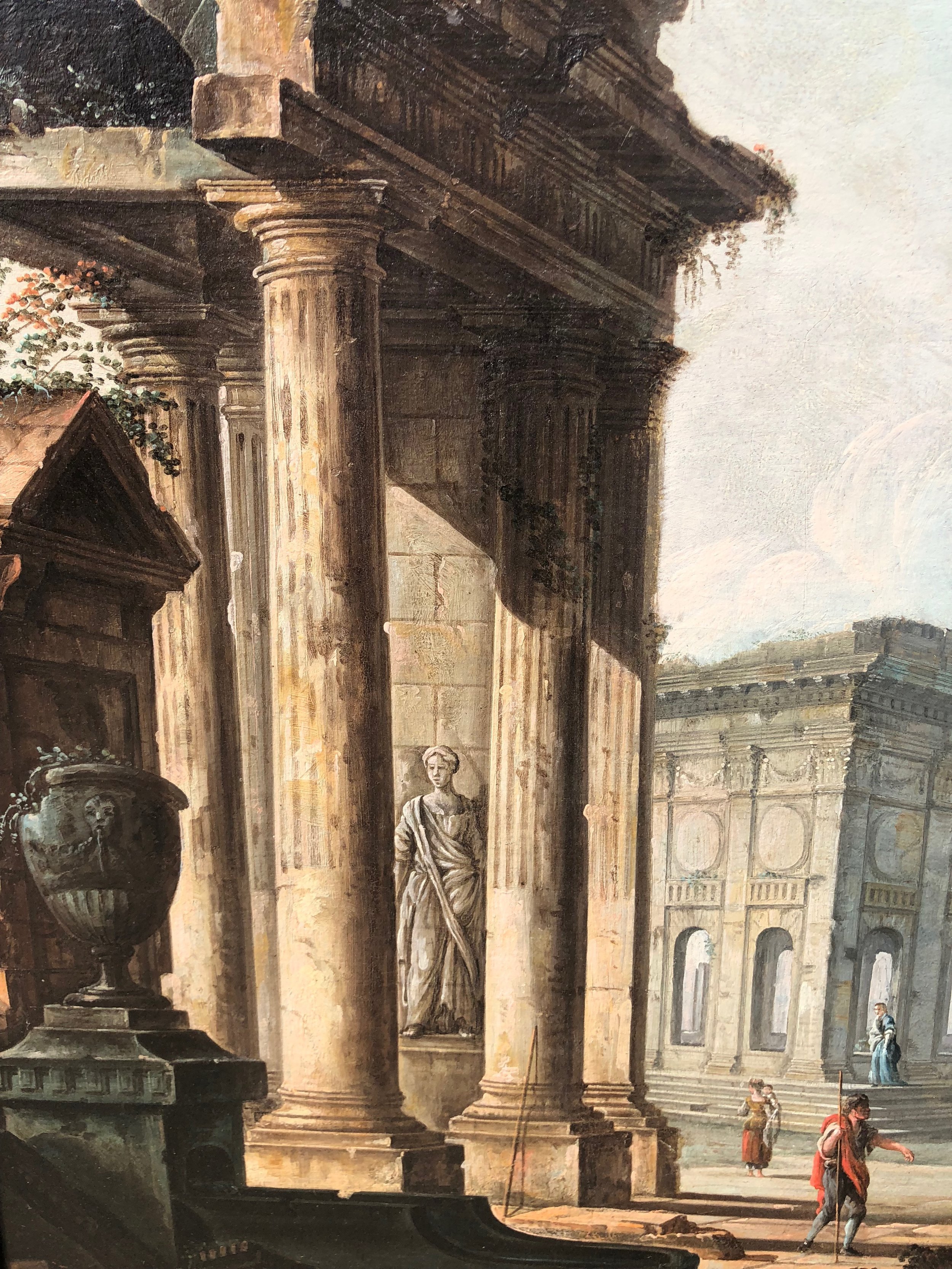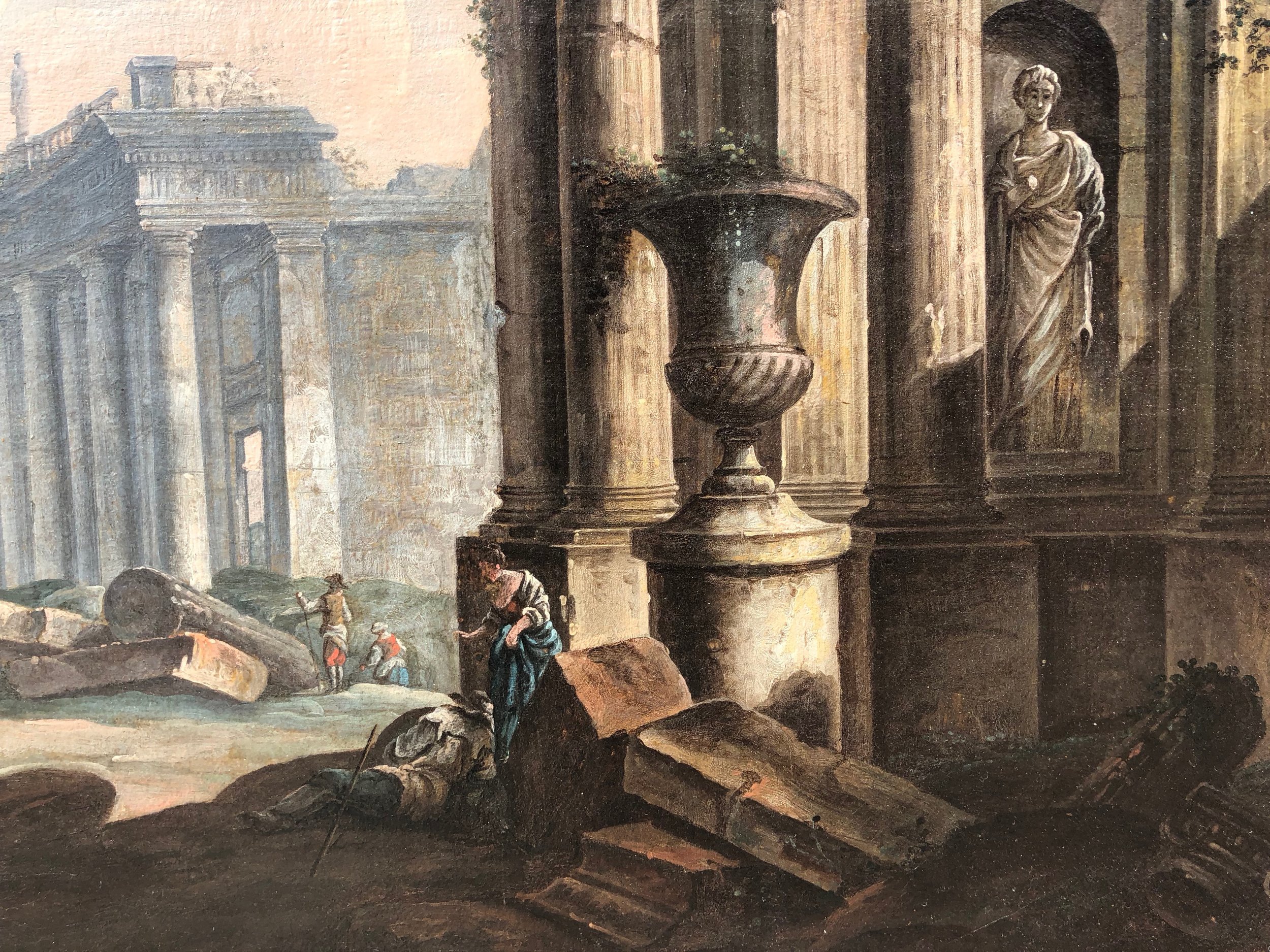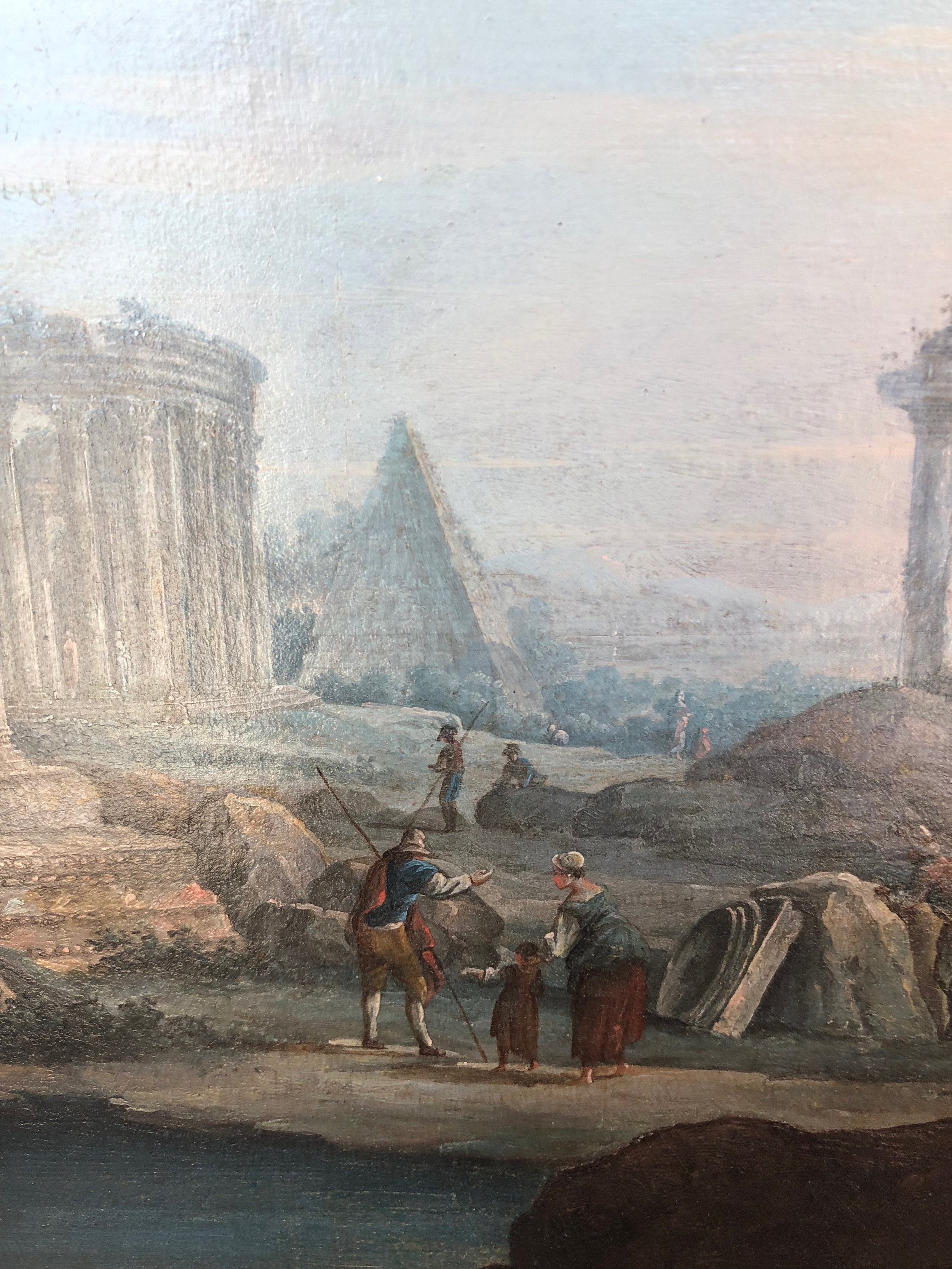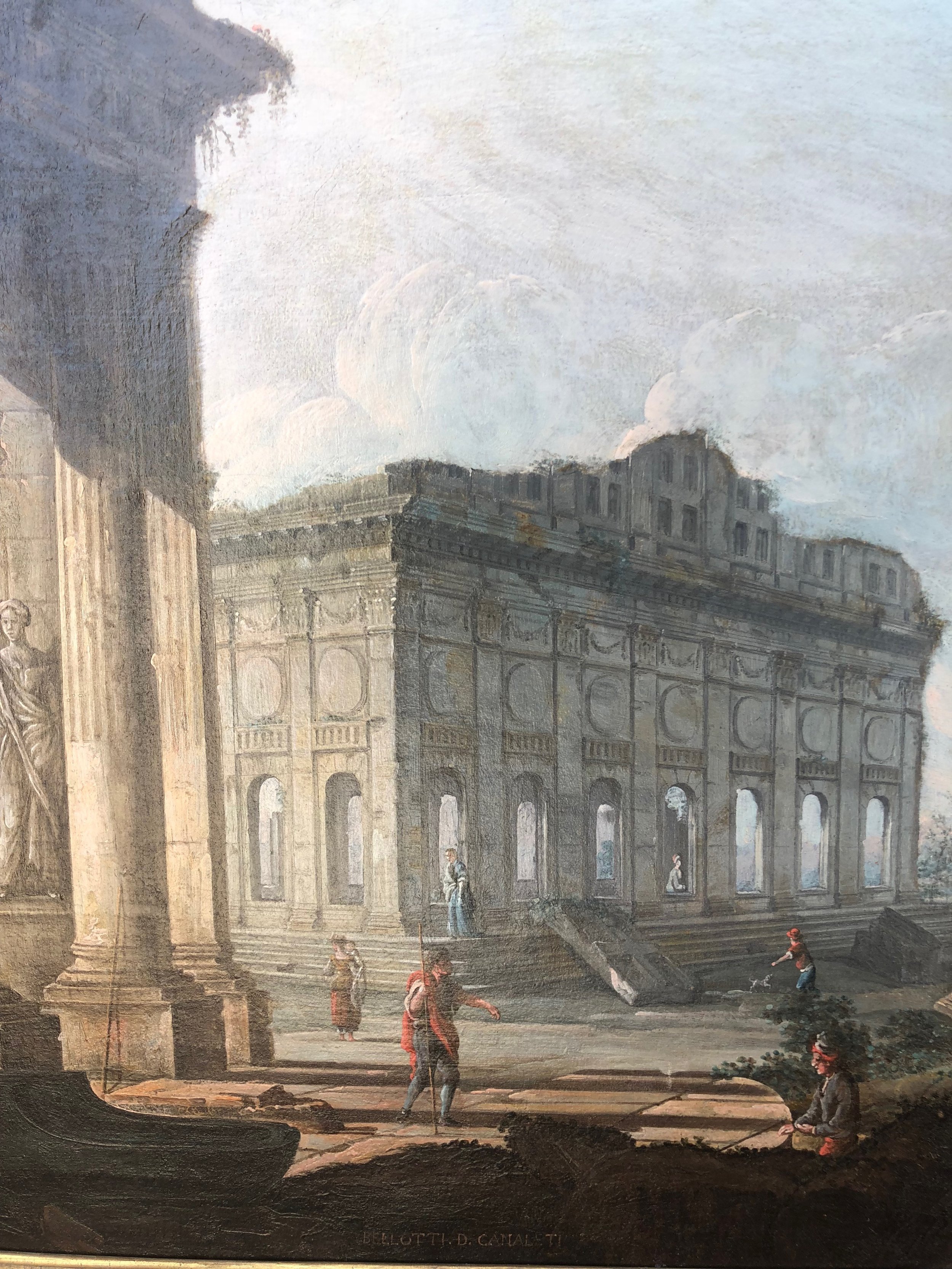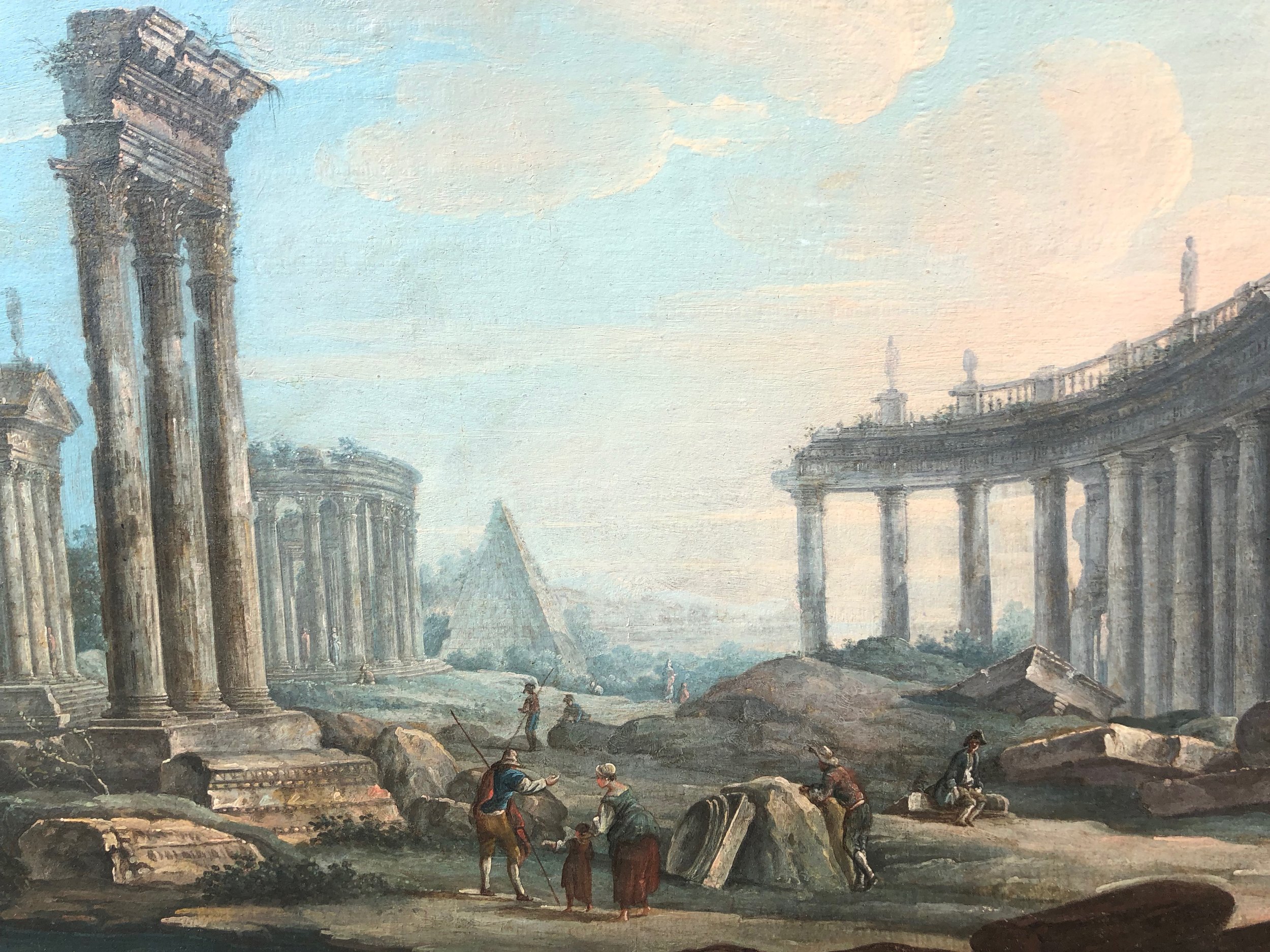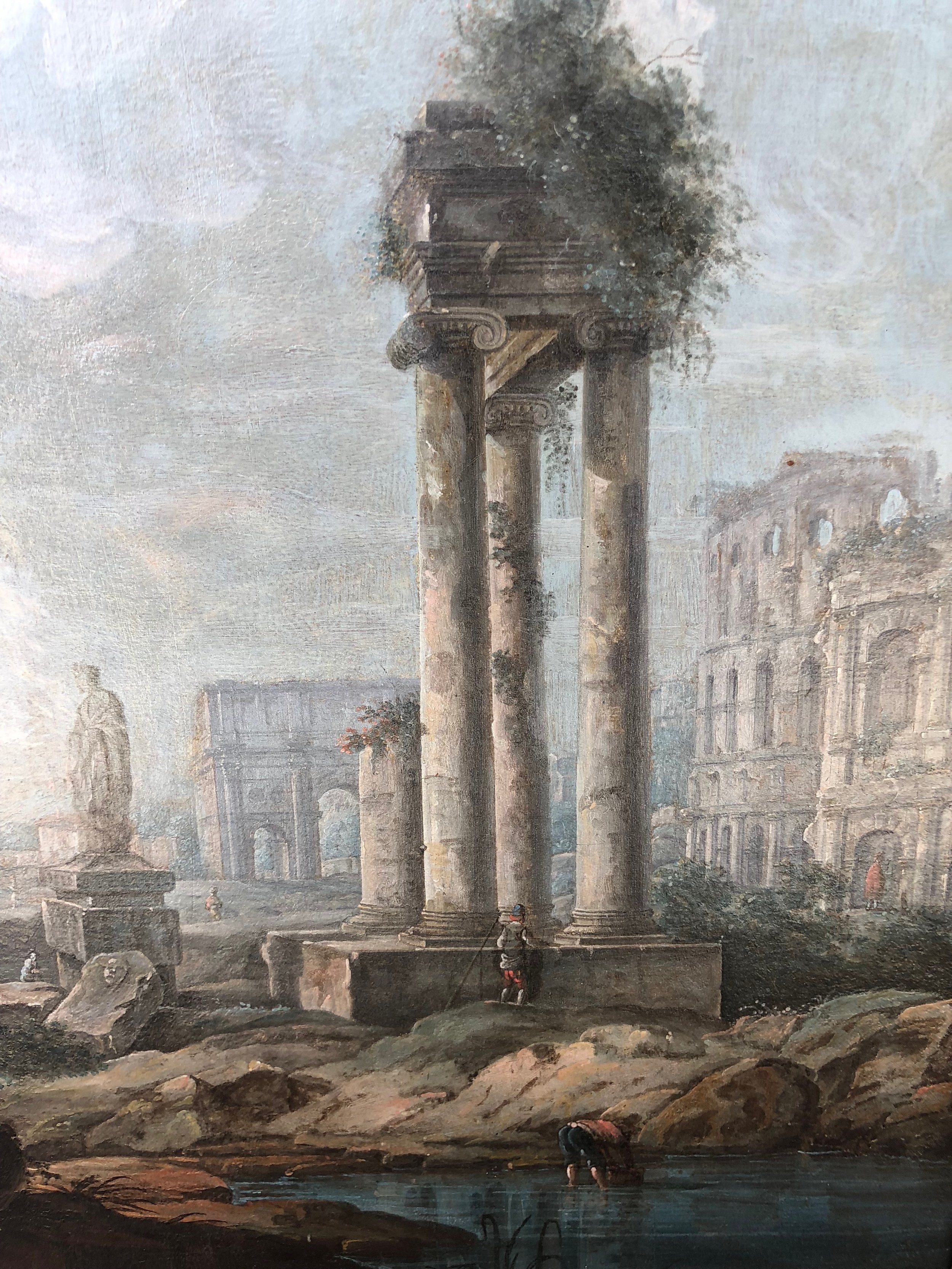Pietro BELLOTTI (b. Venice 1725 – d. c.1800 France, Italian)
A pair of Capricci
Both signed ‘BELLOTTI. D. CANALETI’
With numbers ‘209’ and ‘210’ brushed on the stretchers
Oil on canvas
19 ¼ x 25 ¾ in. (49 x 65.4 cm.)
Price: Sold
Provenance:
Mrs Leon Lauer, by whom given to the Maryland Institute, Baltimore, Maryland.
Exhibited:
Venice, Ca’ Rezzonico, Museo del Settecento veneziano, Pietro Bellotti: un altro Canaletto, 7 December 2013 – 28 April 2014, p. 71, nos. 42-3, illustrated in colour pp. 132-5 (entry by C. Beddington).
Literature:
C. Beddington, ‘Pietro Bellotti in England and elsewhere’, The Burlington Magazine, CXLIX, No. 1255, October 2007, p. 682, figs. 26-7 (colour).
Bernardo Bellotto is only known to have had one pupil in his early years in Venice, his brother Pietro Bellotti,[i] born in 1725, who on 5 November 1741 undertook to pay Bernardo 120 ducats a year for board and training, an arrangement which was terminated on 25 July 1742. Pietro would presumably have been an assistant in Canaletto’s studio for several years before the date of these documents. The probability that he accompanied his brother to Rome in the first half of 1742 is supported by the presence of his name on the back of one of Bernardo’s drawings of Lucca.[ii] He had moved to France by 1748, to judge from the fact that on 24 March 1749 the baptism took place in Toulouse of his first child by a French woman, whom he married the following day.[iii] Pietro’s career and work in Toulouse have been known since Robert Mesuret’s researches in the 1940s and 1950s,[iv] and have since been mentioned in numerous books of a general nature.[v] Paintings by him were exhibited at the Académie Royale in Toulouse at irregular intervals between 1755 and 1790, consisting of views of various European cities and a few capricci, all lent by local collectors. Bellotti seems to have left Toulouse by the 1770s, and he must also be the ‘Pietro Bellotto di Canaleti’ who in 1755 applied for permission to practice his art in Nantes, where he is again mentioned in 1768. He is also documented in Paris and Besançon. pietro is not recorded after 1790, but a Toulouse document of 1818 states that he had died ‘within recent years’. Quite a number of his paintings remain in French private collections and have recently been published
by Anne and Udolpho van de Sandt.[vi] A set of no fewer than seventeen small canvases is recorded in the collection of the Marquis de Beaumont at the Chateau de Merville, near Toulouse, the majority with eighteenth century inscriptions on the reverse identifying the artist as ‘Bellotti’.[vii] the much published and unusually large pair of The Entrance to the Cannaregio and The Castel S. Angelo and the Vatican, once owned by the Président Puget, a recorded patron of Bellotti, and later in the Desarnauts Collection, Toulouse, was sold by Sotheby’s, New York, in 1999.[viii] Four additional paintings have since been published by Dario Succi:[ix] a view of The Molo, looking west, which was subsequently sold at Sotheby’s, London, in 2003,[x] The Lock at Dolo, apparently (uniquely) signed,[xi] and with a pendant Capriccio of Buildings at Padua, and a Capriccio of a walled Town by the lagoon, a variant of one of the Beaumont set.[xii] This not inconsiderable body of work shows Pietro to have been a very competent painter of view paintings, usually based on prints and generally on a small scale. Charles Beddington has added to those a group of paintings which he proposes as works of the painter’s early period in Venice (C. Beddington, ‘Bernardo Bellotto and his circle in Italy. Part 2: The Lyon Master and Pietro Bellotti’, The Burlington Magazine, CXLVII, No. 1222, January 2005, pp. 21-5).
More recently a number of capricci of classical ruins has re-emerged. Works revealing considerably more imagination than is apparent in Bellotti’s previously known work, he was understandably proud of these and several are signed. A pair of upright examples in the Mauritshuis, The Hague, will be published shortly by Sabrina Meloni in Maurithuis in Focus. One of those is signed ‘BELLOTTI DIT CANALETI VENITIEN PEINTRE ROIAL’. Ours is one of only two pairs of which the current location is known of which both components are signed.
With other, unpublished, works a significant œuvre is now known, and Charles Beddington is preparing a catalogue raisonné.
[i] Bernardo and his descendants in Poland seem to have been the only members of the family to spell their name with a final ‘o’. Not be confused with the figure painter Pietro Bellotti (1625-1700).
[ii] In the British Museum; S. Kozakiewicz, Bernardo Bellotto, Recklinghausen and London, 1972, no.60.
[iii] It may be no coincidence that both Canaletto and Bellotto left Venice around this time, the former for England in 1746, the latter for Dresden in 1747.
[iv] See especially R. Mesuret: ‘Pietro Bellotti un veneziano di Tolosa’, Arte Veneta, 6, 1952, pp.170-2.
[v] See, for instance, R. Pallucchini: La pittura veneziana del Settecento, Venice-Rome, 1960, p.228, fig.606; R. Pallucchini: La pittura nel Veneto: Il Settecento, II, ed. M. Lucco et al., Milan, 1996, p.523.
[vi] A. and U. van de Sandt: ‘Alla ricerca di “Pietro Bellotti, un veneziano di Tolosa”’, Saggi e memorie di storia dell’arte, 25, 2002, pp.91-120.
[vii] Van de Sandt, p. 110, figs. 14-16, 18-20, 22, 24 and 26.
[viii] 98.5 by 145.5 cm.; Sotheby’s, New York, 28 January 1999, lot 334; sold after the sale, this is now in a private collection, U.S.A.; Van de Sandt, pp.106 and 119, notes 71-6, figs.7-8.
[ix] D. Succi: ‘Pietro Bellotti: un altro “Canaletto”’, in the catalogue of the exhibition da canaletto a zuccarelli: il paesaggio veneto del Settecento, Villa Manin, Passariano, 2003, pp.164-7, figs.138-40, and pp.394-5, no.111, illustrated in colour.
[x] 62 by 76.7 cm.; Sotheby’s, London, 11 December 2003, lot 42 (purchased by Lampronti).
[xi] ‘Bellotti dit Canalletti’.
[xii] Van de Sandt, fig.10.


